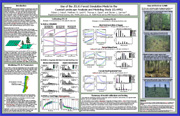|
Forest Growth with
ORGANON and ZELIG
- People
Rob
Pabst: forest ecology, OSU Senior Research Assistant
Matthew Goslin: forest ecology, OSU Research Assistant
Pete
Bettinger: modeling, University of Georgia
Steve Garman:
ecological modeling, OSU
Thomas Spies: landscape ecology,
PNW (Co-leader)
- Modeling stand
development
Our goal is to develop a strategy for projecting the development
of Coast Range forest stands across the entire province.
Two simulation models are being used: ZELIG.PNW.3.0 (Steven
Garman 1995), a process-based ecological model, and ORGANON
(David Hann et al. 1994), an empirical growth and yield
model. Projections of vegetation change across landscapes
depend on our ability to effectively simulate forest development
at the scale of the stand. We need to be able to simulate
the wide variety of initial conditions and management approaches
which occur across the Coast Range: intensively managed
planted stands; young conifer stands treated with alternative
silvicultural methods; mature mixed stands entered repeatedly
with partial cuts; old growth stands with no intervention;
and riparian hardwood stands. ORGANON is a credible model
for growth and yield projections. However, ORGANON was not
intended for use outside this range of stand types or limited
time frame (100 yrs.). In contrast, ZELIG, a theoretical,
ecological model, is capable of modeling a potentially unlimited
range of stand types, management strategies and lengths
of time. ZELIG and other process-based models have wide
currency in the scientific community, whereas ORGANON is
more commonly used by forest managers. To be useful, ZELIG
must be tested and parameterized against real data. We are
using ORGANON on private lands with relatively simple stand
conditions and shorter rotations, and ZELIG on public land
to simulate longer periods of development, complex stand
types, and alternative silvicultural systems.
- Posters
Use of the ZELIG Forest Simulation Model in the Coastal
Landscape Analysis and Modeling Study (CLAMS)

PDF - 2.7 mb |
- Publications
None Available
|